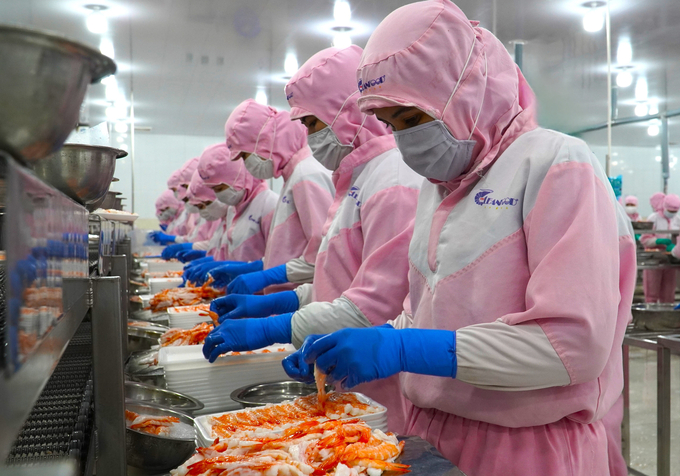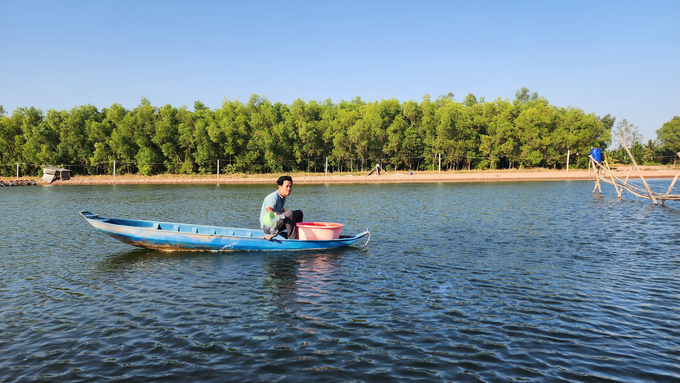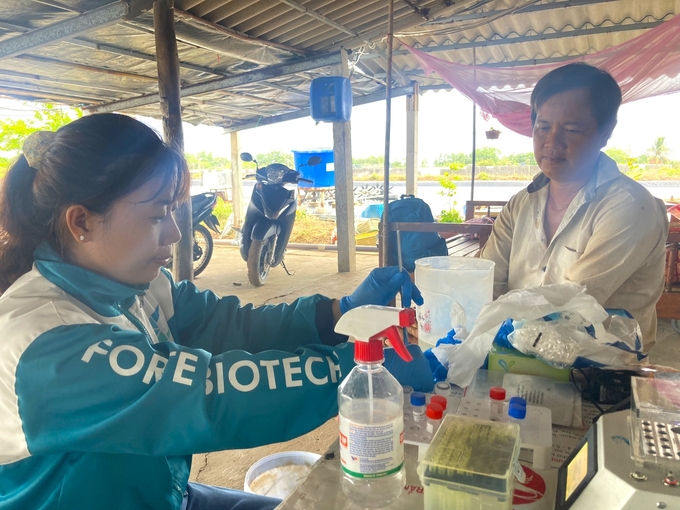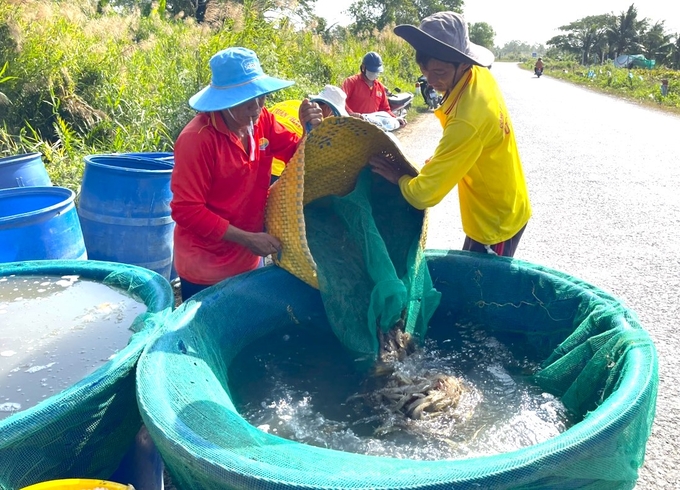November 19, 2025 | 12:40 GMT +7
November 19, 2025 | 12:40 GMT +7
Hotline: 0913.378.918
November 19, 2025 | 12:40 GMT +7
Hotline: 0913.378.918

The development of brackish water shrimp farming areas has generated a substantial supply of raw materials, significantly supporting processing and export businesses. Photo: Van Vu.
The shrimp industry is contributing 40-45% of the total seafood export turnover of Vietnam. The industry draws around 3.5-4 billion USD annually, addressing jobs for over 3 million laborers.
According to the Department of Fisheries statistics, the brackish shrimp farming area nationwide reaches around 737,000 ha, producing over 1 million tons/year in output.
Mekong Delta particularly remains the largest brackish shrimp farming area, accounting for around 687,000 ha (equivalent to 93% of the whole country area) and 86% output (around 874,000).
Alongside its development, the shrimp farming industry is facing significant challenges and risks due to disease outbreaks in farmed shrimp. This has resulted in substantial losses for both farmers and businesses, with a low success rate for each farming cycle.
Finding a solution to quickly, simply, and cost-effectively assess the "health" of farmed shrimp is a pressing issue that is of great interest to the aquaculture sector, farmers, and businesses in the Mekong Delta region.
Currently, there is no definitive cause identified for the outbreak of diseases in farmed shrimp. Several hypotheses have been proposed, including the quality of the shrimp fry, deteriorating farming environments, or changing weather conditions.

The total area of shrimp farming that suffered losses in 2023 was over 22,600 hectares. Photo: Van Vu.
Recently, at a conference related to the shrimp industry held in Can Tho City, Mr. Truong Dinh Hoe, General Secretary of the Vietnam Association of Seafood Exporters and Producers (VASEP), highlighted an alarming figure: the success rate of shrimp farming in Vietnam is only around 30%.
According to the Department of Animal Health (Ministry of Agriculture and Rural Development), the total area of shrimp farming that suffered losses in 2023 was over 22,600 hectares. This figure includes losses due to environmental factors, diseases, and some unidentified causes.
Mr. Dang Van Ngoc, Chairman of the Board and Director of the April 30 Aquaculture Service Cooperative (Hoa Binh District, Bac Lieu Province), stated that shrimp farming used to be quite successful due to a clean environment and fewer diseases.
However, as farmers shifted to intensive and super-intensive shrimp farming models, the amount of waste released into the environment increased, leading to a rise in disease outbreaks and a decrease in the success rate of shrimp farming.
According to Mr. Ngoc's calculations, if previously an average of 100kg of feed was used daily, it has now increased to 1,000kg. A lot of feed is spread into the ponds, but the shrimp only absorb half of it, with the other half being released into the environment.
This is one of the causes of disease outbreaks in farmed shrimp. The immediate damage is evident as many shrimp farmers have had to abandon their ponds and change their profession. Borrowing money and mortgaging land to banks has become commonplace.

With intensive and super-intensive shrimp farming methods, high stocking densities require farmers to use a lot of water and feed, putting pressure on the environment and leading to the emergence of diseases. Photo: Kim Anh.
In Soc Trang, according to a report from the Provincial Fisheries Sub-Department, as of mid-May 2024, the total area of brackish water shrimp farming reached over 13,700 hectares, of which more than 300 hectares suffered losses. Over 50% of the affected area was due to diseases such as acute hepatopancreatic necrosis disease (AHPND), white spot syndrome virus (WSSV), white feces syndrome, and Enterocytozoon hepatopenaei (EHP).
To monitor diseases in the farming areas, the provincial fisheries sector collected 55 shrimp samples. The results showed that 6 out of 55 samples tested positive for WSSV, 11 out of 55 samples tested positive for AHPND, and 6 out of 55 samples tested positive for EHP.
Particularly, in the early months of 2024, the Soc Trang fisheries sector received reports of the emergence of transgenerational pigment discoloration (TPD) disease in the farming areas. Surveillance revealed many ponds experiencing abnormal and rapid shrimp deaths at the 3-7 day old stage.
Epidemiological investigations indicated that most shrimp deaths occurred in densely populated nursery ponds with low water levels of about 0.5 – 0.6 meters. Upon sampling and testing, the specialized agency confirmed that the farmed shrimp were positive for WSSV, EMS (early mortality syndrome), and EHP. Additionally, some samples tested positive for both EMS and EHP simultaneously.
Researchers in the aquaculture field believe that once shrimp are infected with a disease, treatment is not possible. Preventive measures are the main solution to help farmers minimize losses, including thoroughly treating water sources and selecting high-quality shrimp larvae from reputable suppliers.
Currently, farmers primarily determine the health status of shrimp based on experience or by sending samples to laboratories for analysis. However, these methods have drawbacks such as low accuracy, time consumption, and the inconvenience of long-distance travel, especially for rural farmers.

The RAPID toolkit from Forte Biotech can quickly diagnose and provide relatively accurate results for three common diseases in brackish water shrimp: WSSV (white spot syndrome virus), EHP (Enterocytozoon hepatopenaei), and EMS (early mortality syndrome). Photo: Kim Anh.
Additionally, some traditional disease testing methods, such as molecular biology PCR tests, cannot meet the timely needs of large-scale farming operations.
Recently, some farmers in Ben Tre, Bac Lieu, and Ca Mau provinces have become aware of and tested the RAPID toolkit, which helps diagnose and monitor the level of pathogens in shrimp ponds.
This toolkit is a research product of an agri-tech startup, Forte Biotech. According to a representative from this company, the RAPID kit can self-test and provide relatively accurate results for three common diseases in brackish water shrimp: WSSV (white spot syndrome virus), EHP (Enterocytozoon hepatopenaei), and EMS (early mortality syndrome).
The advantage of this solution is that farmers can self-test for shrimp diseases within 60 minutes. The toolkit consists of two devices: a DNA extraction machine and a result reader. Additionally, to accurately determine if shrimp samples are infected with any of the three diseases, a "primer tube" containing the DNA of one of these diseases is required.
Nguyen Dang Quang Minh, co-founder of Forte Biotech, explained that if a shrimp sample introduced into the RAPID toolkit shows signs of infection, the extracted DNA and the DNA in the primer tube will combine, resulting in a positive test. Conversely, if the shrimp are disease-free, the two DNA samples will not connect, and the machine will indicate a negative result.

Specialized agencies have proposed various solutions and recommendations for farmers to prevent and control diseases in farmed shrimp, thereby maintaining economic efficiency. Photo: Kim Anh.
A potential solution involves the application of antibody technology to prevent diseases in shrimp, researched by UV Joint Stock Company. This technology has already been commercialized and applied in practice at several shrimp farms in Soc Trang province, with the capability to help shrimp "resist" certain dangerous diseases.
The Livestock and Animal Health Sub-Department of Soc Trang province advises farmers that there are no specific treatments for WSSV (white spot syndrome virus) and EHP (Enterocytozoon hepatopenaei), and the use of antibiotics for disease prevention is not effective.
Therefore, during the shrimp farming process, farmers need to implement several disease prevention measures such as: thoroughly renovating ponds to eliminate pathogens from previous farming cycles, and maintaining separate water supply and drainage systems. The water used must be treated and disinfected with chemicals approved by the Ministry of Agriculture and Rural Development (MARD).
When selecting shrimp larvae, it's essential to ensure their quality, checking visually and using PCR testing to eliminate batches carrying pathogens. Additionally, farmers should regularly monitor the health of the shrimp, the color of the water, and other environmental indicators.
Translated by Linh Linh

(VAN) Deputy Prime Minister Tran Hong Ha convened a meeting with the MAE and relevant agencies to discuss the draft decree on national multidimensional poverty standards for the 2026 - 2030 period.

(VAN) The year 2025 marks the 10th anniversary since more than 190 countries adopted the Paris Agreement on climate change, paving the way for strengthened global action.

(VAN) The PepsiCo Foundation funded the project ‘New Harvest: Sustainable Agriculture Initiative’, focusing on regenerative agriculture and climate change.

(VAN) Dr. Nguyen Viet Hung, ILRI's Regional Director for Asia, emphasized the One Health approach in ensuring food safety and reducing antimicrobial resistance risks in livestock.

(VAN) The youth-driven initiative ‘Innovate for water, act for the future’ seeks practical, scalable solutions to Vietnam’s water challenges.

(VAN) At the Annual Science Conference of Thuyloi University, Deputy Minister Phung Duc Tien directed researchers to focus on in-depth studies, data harmonization, and solutions linked to real-world practice.

(VAN) After nearly four years of implementation, 5,187 community agricultural extension groups have been established nationwide, with 47,493 members participating.